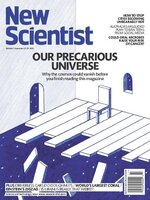New Scientist covers the latest developments in science and technology that will impact your world. New Scientist employs and commissions the best writers in their fields from all over the world. Our editorial team provide cutting-edge news, award-winning features and reports, written in concise and clear language that puts discoveries and advances in the context of everyday life today and in the future.
Elsewhere on New Scientist
Not just skin deep • An industry founded on beauty ideals could be due a makeover
New Scientist
3D-printed rocket blasts off
Rewilding could be a big climate fix • Protecting or expanding wildlife populations can make a large contribution to carbon removal
Astronauts on the moon could mine water from glass
CERN measurement casts doubt on shock W boson result
Ancient humans got a taste for roasted snails very early on
Analysis Artificial intelligence • Are chatbots really able to think like people? The lofty goal of artificial general intelligence is within reach, according to researchers at Microsoft, but others are sceptical, finds Matthew Sparkes
World population could soon peak • Working to reduce inequality could see the human population fall to 6 billion by 2100
Dormice glow brilliantly under ultraviolet light
Europe averted a crisis over winter, but what happens next time round?
Analysis Artificial intelligence • The problem with an unusually fashionable pope We are in a new age of misinformation as a result of the growth of image-generating tools, says Chris Stokel-Walker
JWST telescope finds TRAPPIST-1b may have no atmosphere
Why is cancer rising in younger people? • The number of people under 50 with cancer is increasing in many countries and for many different tumour types. The hunt is on to find out why, reports Clare Wilson
Fissures on icy ocean moons may be too rare to provide conditions for life
Wrinkly graphene could transform hydrogen fuel cells
Safe drinking water remains out of reach for billions
Asteroid samples contain a building block of RNA
Shape discovered that can tile a wall and never make a pattern that repeats
Botox injections alter brain activity linked to emotions
Cheesecake made by a 3D printer
Key to sleep may be a high-protein diet
Parasite from cat faeces killed four sea otters
Really brief
Let them eat cake • We are trapped in a junk food cycle that is making us sick. The food system is broken, say Henry Dimbleby and Jemima Lewis
Field notes from space-time • Why space scientists need science fiction Carl Sagan’s novel Contact, in which Ellie Arroway searches for alien intelligence, has been an inspiration and a guide, says Chanda Prescod-Weinstein
Wild beauty
Your letters
Building your digital twin • It would be the ultimate in personalised medicine: a virtual “you” with which doctors could predict your health. But is it possible, asks Claire Ainsworth
Ghosts in the brain? • Many people feel an uncanny “presence” when no one is there. Jason Arunn Murugesu probes a lively book that asks why
Don’t miss
Maths by the book • An engaging read about how central mathematics is to literature by authors from George Eliot to Georges Perec is a homage to both subjects, finds Tom Tierney
Timing a bit off in dino thriller
The truth about wrinkles • Far from being a purely cosmetic concern, wrinkles may be a driver of ageing in the body and brain, finds Graham Lawton
Head in the clouds • In a lifetime of tree climbing, Nalini Nadkarni has led the way in discovering the secrets of cloud forest biology. Interview by Matthew Ponsford
Black holes from a previous universe • Space...

 Dec 14 2024
Dec 14 2024
 Dec 07 2024
Dec 07 2024
 Nov 30 2024
Nov 30 2024
 Nov 23 2024
Nov 23 2024
 Nov 16 2024
Nov 16 2024
 Nov 09 2024
Nov 09 2024
 Nov 02 2024
Nov 02 2024
 Oct 26 2024
Oct 26 2024
 Oct 19 2024
Oct 19 2024
 Oct 12 2024
Oct 12 2024
 Oct 05 2024
Oct 05 2024
 Sep 28 2024
Sep 28 2024
 Sep 21 2024
Sep 21 2024
 Sep 14 2024
Sep 14 2024
 Sep 07 2024
Sep 07 2024
 Aug 31 2024
Aug 31 2024
 Aug 24 2024
Aug 24 2024
 Aug 17 2024
Aug 17 2024
 Aug 10 2024
Aug 10 2024
 Aug 03 2024
Aug 03 2024
 Jul 27 2024
Jul 27 2024
 Jul 20 2024
Jul 20 2024
 Jul 13 2024
Jul 13 2024
 Jul 06 2024
Jul 06 2024
